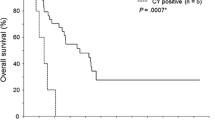Abstract
Background
Positive peritoneal cytology is classified as M1 disease in gastric and pancreatic cancer. While peritoneal cytology is typically obtained by laparoscopic peritoneal lavage, this study sought to examine the feasibility and safety of performing this percutaneously, with monitored anesthesia care and in combination with other diagnostic procedures to condense and expedite the staging process.
Methods
Patients with gastric or pancreatic cancer scheduled for laparoscopy with peritoneal lavage were prospectively enrolled to undergo intraoperative percutaneous peritoneal lavage prior to laparoscopic peritoneal lavage. Saline was infused through a percutaneously-inserted catheter and fluid was collected for peritoneal cytology. Three-quadrant washings collected during laparoscopy were also sent for peritoneal cytology. The primary outcome was to evaluate the sensitivity and specificity of percutaneous peritoneal lavage for detecting positive peritoneal cytology compared with the gold standard of laparoscopic peritoneal lavage, while the secondary outcome was to determine safety.
Results
Percutaneous peritoneal lavage was successfully performed in 70 of 76 patients (92%). Ten of 48 gastric cancer patients (21%) and three of 22 pancreatic cancer patients (14%) had positive percutaneous and laparoscopic peritoneal cytology. Two additional gastric cancer patients had positive laparoscopic peritoneal cytology only. Sensitivity and specificity of percutaneous peritoneal lavage compared with laparoscopic peritoneal lavage were 87% and 100%, respectively. No complications occurred with percutaneous peritoneal lavage.
Conclusions
Percutaneous peritoneal lavage is a safe and effective minimally invasive alternative to laparoscopic peritoneal lavage for the diagnosis of metastatic gastric and pancreatic cancer. It is possible this can be utilized in an outpatient setting, such as during endoscopy, to allow for earlier diagnosis of M1 disease and decreased time to appropriate treatment.

Similar content being viewed by others
References
Washington K. 7th edition of the AJCC cancer staging manual: stomach. Ann Surg Oncol. 2010;17(12):3077–9.
Edge SB, Byrd DR, Compton CF, Fritz AG, Greene FL, Trotti A. AJCC cancer staging manual. 7th ed. New York: Spinger; 2010.
Leach SD, Rose JA, Lowy AM, et al. Significance of peritoneal cytology in patients with potentially resectable adenocarcinoma of the pancreatic head. Surgery. 1995;118(3):472–8.
Lei S, Kini J, Kim K, et al. Pancreatic cancer. Cytologic study of peritoneal washings. Arch Surg. 1994;129(6):639–42.
Midwinter MJ, Watson A, Wadehra V, et al. Laparoscopic peritoneal lavage cytology and immunocytology in pancreatic and periampullary carcinoma. HPB (Oxford). 2001;3(3):207–11.
Jimenez RE, Warshaw AL, Rattner DW, et al. Impact of laparoscopic staging in the treatment of pancreatic cancer. Arch Surg. 2000;135(4):409–14; discussion 414–5.
Nieveen van Dijkum EJ, Sturm PD, de Wit LT, et al. Cytology of peritoneal lavage performed during staging laparoscopy for gastrointestinal malignancies: is it useful? Ann Surg. 1998;228(6):728–33.
Jimenez RE, Warshaw AL, Fernandez-Del Castillo C. Laparoscopy and peritoneal cytology in the staging of pancreatic cancer. J Hepatobiliary Pancreat Surg. 2000;7(1):15–20.
Clark CJ, Traverso LW. Positive peritoneal lavage cytology is a predictor of worse survival in locally advanced pancreatic cancer. Am J Surg. 2010;199(5):657–62.
Root HD, Hauser CW, McKinley CR, et al. Diagnostic peritoneal lavage. Surgery. 1965;57:633–7.
11. Cue JI, Miller FB, Cryer HM 3rd, et al. A prospective, randomized comparison between open and closed peritoneal lavage techniques. J Trauma. 1990;30(7):880–3.
Saunders CJ, Battistella FD, Whetzel TP, et al. Percutaneous diagnostic peritoneal lavage using a Veress needle versus an open technique: a prospective randomized trial. J Trauma. 1998;44(5):883–8.
Hodgson NF, Stewart TC, Girotti MJ. Open or closed diagnostic peritoneal lavage for abdominal trauma? A meta-analysis. J Trauma. 2000;48(6):1091–5.
Fischer RP, Beverlin BC, Engrav LH, et al. Diagnostic peritoneal lavage: fourteen years and 2,586 patients later. Am J Surg. 1978;136(6):701–4.
Henneman PL, Marx JA, Moore EE, et al. Diagnostic peritoneal lavage: accuracy in predicting necessary laparotomy following blunt and penetrating trauma. J Trauma. 1990;30(11):1345–55.
Davis JW, Hoyt DB, Mackersie RC, et al. Complications in evaluating abdominal trauma: diagnostic peritoneal lavage versus computerized axial tomography. J Trauma. 1990;30(12):1506–9.
Nagy KK, Roberts RR, Joseph KT, et al. Experience with over 2500 diagnostic peritoneal lavages. Injury. 2000;31(7):479–82.
Hanley JA, Lippman-Hand A. If nothing goes wrong, is everything all right? Interpreting zero numerators. JAMA. 1983;249(13):1743–5.
Burke EC, Karpeh MS Jr, Conlon KC, et al. Peritoneal lavage cytology in gastric cancer: an independent predictor of outcome. Ann Surg Oncol. 1998;5(5):411–5.
Bando E, Yonemura Y, Takeshita Y, et al. Intraoperative lavage for cytological examination in 1,297 patients with gastric carcinoma. Am J Surg. 1999;178(3):256–62.
Makary MA, Warshaw AL, Centeno BA, et al. Implications of peritoneal cytology for pancreatic cancer management. Arch Surg. 1998;133(4):361–5.
Hirabayashi K, Imoto A, Yamada M, et al. Positive intraoperative peritoneal lavage cytology is a negative prognostic factor in pancreatic ductal adenocarcinoma: a retrospective single-center study. Front Oncol. 2015;5:182.
23. Ferrone CR, Haas B, Tang L, et al. The influence of positive peritoneal cytology on survival in patients with pancreatic adenocarcinoma. J Gastrointest Surg. 2006;10(10):1347–53.
Mezhir JJ, Posner MC, Roggin KK. Prospective clinical trial of diagnostic peritoneal lavage to detect positive peritoneal cytology in patients with gastric cancer. J Surg Oncol. 2013;107(8):794–8.
Mezhir JJ, Shah MA, Jacks LM, et al. Positive peritoneal cytology in patients with gastric cancer: natural history and outcome of 291 patients. Ann Surg Oncol. 2010;17(12):3173–80.
Acknowledgements
None.
Disclosure
Dr. Linda Pak received support from the Clinical and Translation Science Center at Weill Cornell Medical Center and Memorial Sloan Kettering Cancer Center (Grant Number UL1TR00457).
Funding
This work was supported in part by NIH/NCI P30 CA008748 Cancer Center Support Grant.
Author information
Authors and Affiliations
Corresponding author
Rights and permissions
About this article
Cite this article
Pak, L.M., Coit, D.G., Eaton, A.A. et al. Percutaneous Peritoneal Lavage for the Rapid Staging of Gastric and Pancreatic Cancer. Ann Surg Oncol 24, 1174–1179 (2017). https://doi.org/10.1245/s10434-016-5757-3
Received:
Published:
Issue Date:
DOI: https://doi.org/10.1245/s10434-016-5757-3




